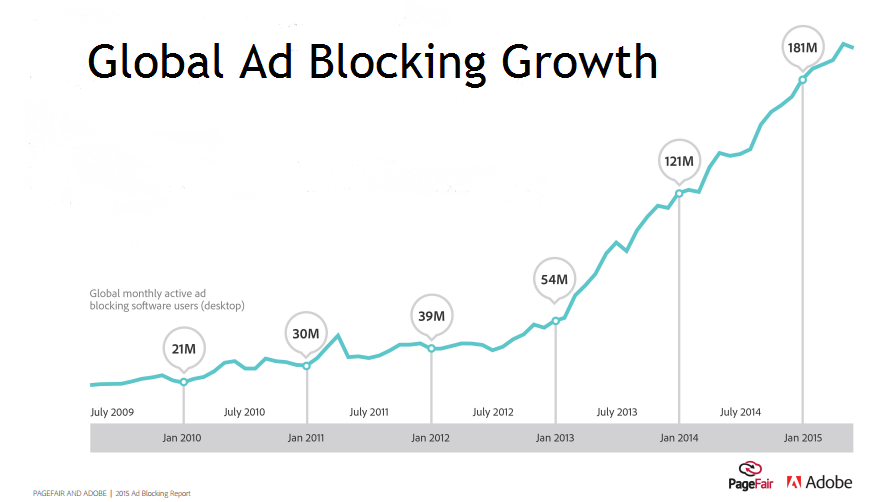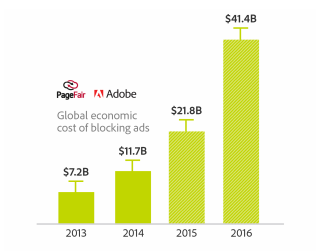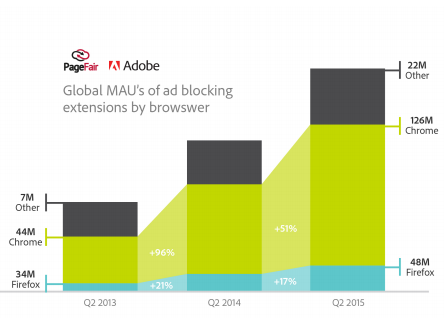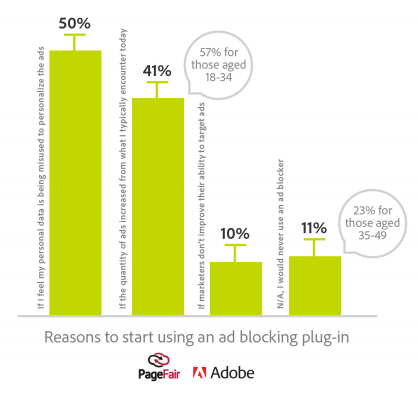PageFair in collaboration with Adobe has released their third annual report on Ad Blocking. Ad Blocking blocks the interface between the web browser and ad service provider. The popular ways to do so is through ad blocking extensions such as AdBlock Plus and AdBlock, DNS or VPNs solution etc. This report shares insight on how Ad Blocking software usage has been growing, its regional and global impact and how it is affecting the mobile advertising space.
You can view the entire report here.
Here are the key highlights of the report:
- Ad Blocking increased globally by 41% YoY. Talking about US specifically, the ad blockers grew by 48% increasing the blockinng software user to 45 million in Q2 this year. In Europe this trend has risen by 35% with average monthly blocking software users increasing to 77 million active users.

- In US the ad blocking usage has resulted in blocking $5.8 billion in 2014 and is estimated to reach $10.7 billion in 2015. The global cost of blocking ads is expected to rise to $41.4 billion by 2016. Further analysis has revealed that though of the global internet population only 6% amount to users using the ad blocking software, however, the ad blocking spend is 14% (cost of $21 billion in 2015) of the global ad spend.

- It is observed that mobile ad blocking is still underdeveloped. Only 1.6% ad block traffic on Page Fair network were from mobile devices. However with the advancement of technology in mobile, the ad blocking usage will get another catalyst in the coming time. It was found that the Firefox mobile browser has a 40% mobile ad blocking share and Chrome has a 53% share in it globally.
- Overall Google Chrome contributed massively in ad blocking usage. Though Google makes money out of online advertising, it is heading in bringing ad blocking to the users. Figures state that the ad block usage has increased by 51% in Chrome and 17% in Firefox.

- Another crucial point discovered was why users were opting for ad blocking extensions. About 50% of the 400 respondents surveyed said that it was because of personal information misuse. 41% of the respondents feared that the quantity of ads might increase whereas only 11% had no desire to ever use an ad blocking software.

- Recently an article about iOS 9 shared insight on a new feature called Content Blockers, that lets users install apps to block unwanted content. Owen Williams put the content blockers to test and said:
The effect of using a content blocker on iOS is, to be honest, something publishers should be deeply afraid of. I don’t really care about advertising actually appearing on sites, I just care about how fast the site itself loads over a constrained connection.
He further elaborates how Apple’s new features is bound to bring about a revolution in mobile ad-blocking. He stress on the fact that, Apple is in a complete win-win situation as it pushes the publishers to opt for a platform where it can take a share from their revenue. Read this article here.





Stop the wasted ad spend. Get more conversions from the same ad budget.
Our customers save over $16 Million per year on Google and Amazon Ads.